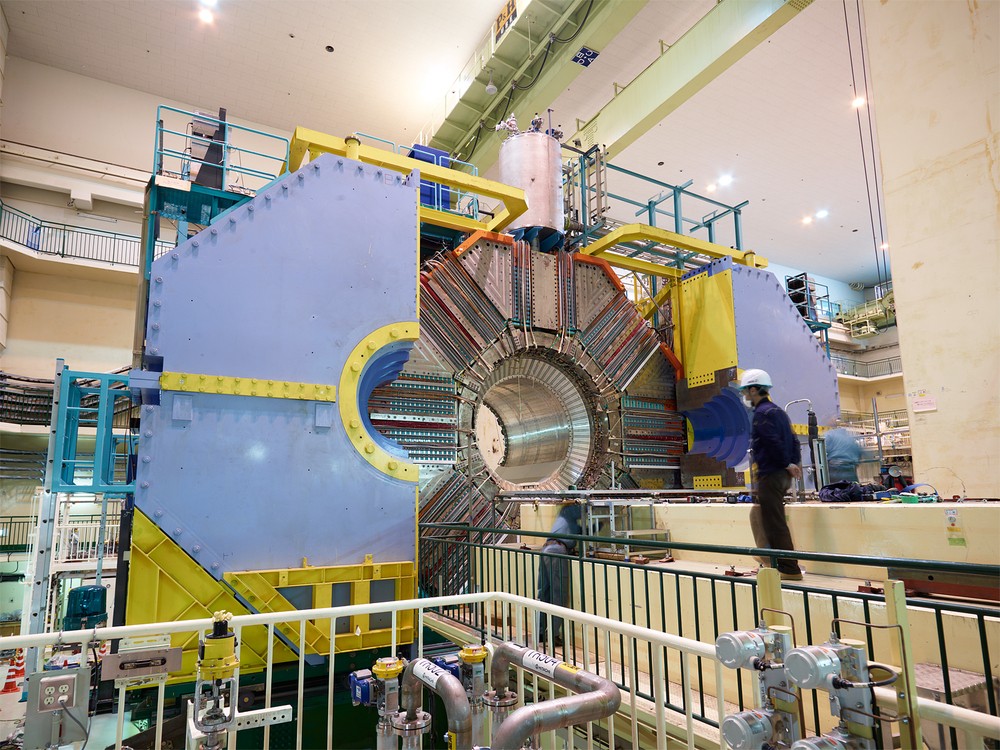
UC physicists celebrate Japan collider record
Record particle collisions raise tantalizing possibilities for new physics
University of Cincinnati physicists celebrated a new world record as part of a research team working on a Japanese particle collider.
The SuperKEKB collider in Japan’s High Energy Accelerator Research Organization observed a record rate of particle collisions, referred to as luminosity, since launching in 2018. And this is only the beginning. The collider is expected to top that record 40 times over in coming years as researchers try to explain basic principles of the universe.
UC physicists Kay Kinoshita and Alan Schwartz are pursuing several topics including dark matter, which is believed to make up a majority of the matter in the universe but hasn’t been observed, at least directly.
“We hope our accelerator experiment can detect dark matter if it exists in a way that hasn’t been probed before,” Kinoshita said.

UC physicist Kay Konishita, seen in her office, is part of an international team of experimental physicists working on the SuperKEKB accelerator. Photo/Joseph Fuqua II/UC Creative + Brand
More collisions mean more opportunity to explore puzzles of particle physics that could help explain fundamental forces in the universe: like why matter prevails over antimatter. The accelerator fires positrons and electrons at each other around a 3-kilometer ring. When they collide, they often create new matter.
“We observe dark matter indirectly from astronomical observations. The question is what is it?” Kinoshita said. “This experiment is looking in new corners of possibility that have opened up.”
Particle physicists are especially excited about SuperKEKB because of its potential for observing more unusual phenomena.
This experiment is looking in new corners of possibility that have opened up.
Kay Kinoshita, UC physics professor

UC physics professor Alan Schwartz stands over a piece of precision-crafted quartz in his optics lab. He and his students built a detector for use at the Japanese particle accelerator using similar bars of quartz. Photo/Andrew Higley/UC Creative + Brand
Schwartz and his students designed and built one of the particle detectors at the collider. They used precision-crafted bars of optical-grade quartz that they assembled on site to identify new particles created by the collisions.
“This milestone represents a significant advance in accelerator design,” Schwartz said. “The accelerator uses the so-called ‘nano-beams’ approach, in which the beams are squeezed in the vertical direction to become very thin.”

UC physics professor Kay Kinoshita has been exploring particle physics her entire career. Photo/Joseph Fuqua II/UC Creative + Brand
Schwartz said this greatly increases the likelihood of electrons colliding with positrons traveling at each other at nearly the speed of light.
Schwartz said SuperKEKB will be flattening the twin beams even more to just 60 nanometers, or less than 1% the diameter of a human hair. Likewise, the collider will generate more electrons and positrons to generate more collisions and more data.
The global pandemic has interrupted international travel for the UC physicists. But SuperKEKB has continued to run, and the Belle II experiment to accumulate data, thanks to members around the world taking turns around the clock to monitor its operation remotely. Kinoshita finished training to supervise one of these remote shifts.
“It is pretty intense. These experiments are incredibly complex. So many things can go wrong,” she said.
But Kinoshita has been preparing for this experiment her entire 38-year academic career. She has been working in experimental particle physics since 1982.
“It’s fun because it’s challenging. You know you’re working on things nobody has ever worked on before,” she said.
Featured image at top: Japan's SuperKEKB accelerator hit a milestone by setting a new world record for particle collisions. Photo/KEK

UC physics professor Alan Schwartz is part of an international team of physicists working on experiments at SuperKEKB in Japan. He has conducted experiments at physics labs around the world. Photo/Andrew Higley/UC Creative + Brand
Impact Lives Here
The University of Cincinnati is leading public urban universities into a new era of innovation and impact. Our faculty, staff and students are saving lives, changing outcomes and bending the future in our city's direction. Next Lives Here.
Stay up on all UC's COVID-19 stories, read more #UCtheGood content, or take a UC virtual visit and begin picturing yourself at an institution that inspires incredible stories.
Related Stories
UC's art collection on display at the Contemporary Arts Center
January 5, 2026
University of Cincinnati leaders joined WVXU's Cincinnati Edition to talk about the university’s 200-year-old art collection, a new exhibition at the Contemporary Arts Center and the release of a companion book exploring the collection’s role in education and public engagement.
UC biochemistry student explores world of taste
January 5, 2026
A University of Cincinnati biochemistry student changed her career trajectory after being inspired by internships with a European Fortune 500 company.
Study finds police officers face higher long-term health risks
January 2, 2026
J.C. Barnes, a University of Cincinnati professor, is interviewed by Spectrum News about new research showing that the physical and psychological demands of law enforcement can contribute to earlier deaths.
